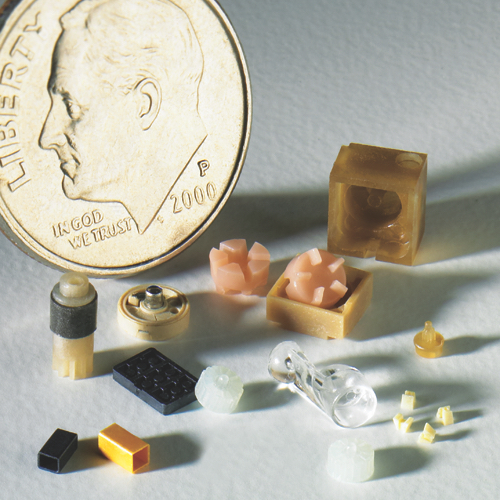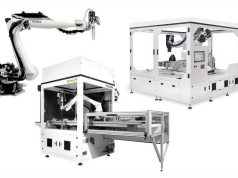This article is a reflection on the advancement of micro additive manufacturing from the perspective of Accumold VP of Marketing and Customer Strategy, Aaron Johnson.
Having been working at the bleeding edge of product development most of my professional career, I have gotten used to hearing the fanfare that surrounds new and emerging technologies — that have the power to change the way things are done, for the better and often in radical ways — and digesting a plethora of information to get to the essence of how such disruptive technologies can be used to the betterment of manufacturing outcomes.
Take the area of additive manufacturing (AM) as an example. AM in its many guises (rapid prototyping, 3D printing) has been with us as a technology for over three decades. And it is fair to say that it has been disrupting industry for over three decades. But just how disruptive can a technology be if it is still disrupting over 30 years after it came on the scene. It must be disrupting very slowly and very gently!
Well, AM is quite unique in that over that 30 years, it has completed one adoption cycle and become a mature and ingrained technology in the area of industrial prototyping. But, as it has evolved, and become more robust, more accurate, more sophisticated, it is now being adopted as a production technology where the demands on repeatable tolerance attainment and surface finish are increasing exponentially.
In fact it may be fair to say that AM is now on its third adoption cycle, as within the last couple of years, the technology has been refined to such an extent that it can now manufacture micro parts with micron features and tolerances, and so is penetrating the micro manufacturing sector and disrupting the way in which miniaturised parts and components can be produced in prototype and production runs. Here it exists as a complementary technology to our core micro molding technology, and so can legitimately be seen as a disruptive technology 30 years after it appeared on the market.
It’s an evolution situation
And this gets to the nub of this article. Innovative and disruptive technologies do not just arrive on the market, disrupt, get adopted, and become the norm. No, such technologies also evolve, and as they evolve their ability to disrupt continues, especially where an industry dynamic is constantly requiring something better and better, or in our case, smaller and smaller.
So you need to begin to look at disruption in a slightly different way.
New technologies and solutions arrive on the market to service a need. AM catered for the need to reduce the time to market, truncating the time from design inception to marketable products. It also, on a production footing, changes the manufacturing paradigm, making parts without the need for tooling, promoting design freedom, facilitating the manufacture of products with hitherto impossible geometric complexity. The underlying demands —innovative parts to market quicker and quicker — will never change, and it is these demands that are disruptive, with technologies like AM providing an initial solution which needs to evolve and develop to keep up with the never-ending need for greater innovation and shorter and shorter product development windows.
And in the area of the manufacture of precision plastic parts and components where Accumold wields it influence, the disruptive force that has led to an array of disruptive technologies is miniaturisation, the need for smaller and smaller parts and components in order to reduce product footprint, reduce weight, and promote minimally invasive surgery etc.
Put quite simply, if industry didn’t want smaller parts, there would have been no demand for the development of micro molding machines, or micro AM technologies. So again, disruptive trends and demands lead to the development of technologies that can fulfil industry requirements, and industry never stops demanding more and more. So after initial disruption, the disruption continues pretty much forever. Disruption is not an event, it is an on-going process.
Will there ever be a point in time when industrial manufacturers say, “You know, as of today I don’t want to reduce my product development time any more, I don’t want greater innovation in product shape and geometries, and I don’t want smaller parts and components”? The answer is obviously “no”. The genie is out of the bottle, and manufacturers will always try to push the envelope.
Precision to me, precision to you
Taking a look at the disruptive miniaturisation trend, industry and suppliers like Accumold have been on a journey of disruption for decades. We work in an area of industry where definitions are somewhat vague. We make precision plastic parts and components. But what is precise to one company is not precise to another, and has certainly changed over the decades.
The parts we are making today would have been impossible when we started out over 30 years ago. They would have been seen as ridiculously precise, the stuff of science fiction. Making them science fact is not just facilitated by a new technology exploding into the market and changing everything, The disruption is in fact a relatively slow process of gradual technological advancement, and also the accretion of expertise and knowledge that drives innovation.
But which came first, the chicken or the egg. Was it market demand that led to innovation, or innovation that led to market demand?
Well, to my mind the answer is neither, or more precisely both. For sure the stimulus comes from market. Various industries, for example electronics or medical, ramped up demand for smaller parts and components to enhance micro-electronic devices or minimally invasive treatment or diagnostic tools. Suppliers like Accumold sharpened their pencils and set to work using our expertise to refine technology and process to fulfil demand. But over time, and with accumulated expertise, experts such as Accumold begin to enhance capability to such as extent that they begin to lead manufactures into the creation of parts and components only possible through a constant refinement and increased level of sophistication of technology and process.

Micro molding
As we stand today, in the area of micro molding, expert companies such as Accumold have honed the art of precision plastic part manufacture to such an extent that in a gradual way we are disrupting precision molding every day. There are no huge Eureka moments every week, instead — built up over decades — the company has developed such a grip on the production of tiny plastic parts in volume that it consistently pushes the envelope, and tolerances are getting smaller and innovative geometries and functionality is being enhanced all the time.
This is not down to one thing. This is not down to the development of one technology enhancement that suddenly makes all previous advancements redundant. It is the accumulation under one roof of design and materials expertise, micro tolling expertise, micro molding expertise, validation expertise, and automated assembly expertise. It comes from dedicated teams that have been working together for years optimising process, and refining and sourcing best-in-class technologies.
The micro molding space is highly dynamic. The trend towards miniaturised parts or larger parts with micron features is constantly gathering pace across industry, and the challenges in terms of exacting applications are an everyday experience. While technology is constantly evolving to meet these challenges, Accumold maintains that the real value for customers partnering with us is in the extent of, values of, passion of, and experience of the micro molding team. It is after all the team that is able to get the most from the technologies on the table.
The journey continues
So let’s finish by going back to our old friend micro-AM, a recent entrant into the precision plastic part manufacturing arena. Do we all now put our hard hats on and wait for this apparently most disruptive of disruptive technologies to turn everything on it shead. Will we be walking into our premises in a year’s time to see our hundreds of micro molding machines being wheeled off to the scrap yard.
No we will not. We have invested in micro-AM, more specifically the Fabrica 2.0 machine from Nano Dimension. But for us it is not a replacement technology, but something complimentary to our existing technology portfolio. It will make the prototype stage of the product development process that much more flexible, and quicker for our customers, It will move towards small to medium sized production runs and promote creative geometric complexity, and mass customisation in time.
In other words, it is another step in our disruptive journey. A journey we have been on for decades and which we will continue on for decades to come as we lead the quest for the smallest features on the most innovative products possible.
For more information about Accumold, please visit www.accu-mold.com.
Subscribe to our Newsletter
3DPResso is a weekly newsletter that links to the most exciting global stories from the 3D printing and additive manufacturing industry.























